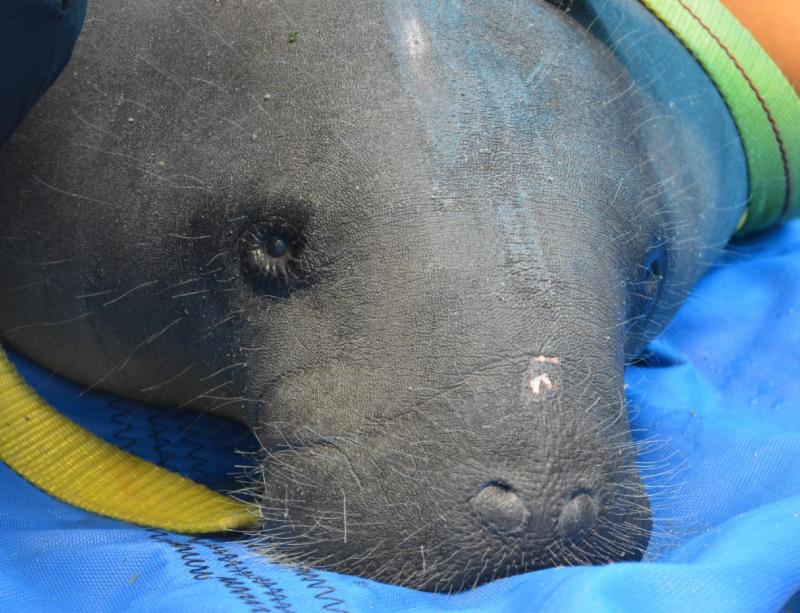The South Florida Museum said a fond farewell to Tannebaum  the manatee on Nov. 5 as he returned to the wild 11 months after an entanglement in dock line nearly severed his tail.
the manatee on Nov. 5 as he returned to the wild 11 months after an entanglement in dock line nearly severed his tail.
Tannebaum, an adult male manatee that was rescued from the mouth of the Caloosahatchee River in Fort Myers in January, was returned to the wild as part of a joint effort of the Museum, the Clearwater Marine Aquarium and Florida’s Fish and Wildlife Conservation Commission. He was returned to the wild at Koreshan State Park in Estero, south of Fort Myers, during Manatee Awareness Month. November is designated by Florida to celebrate manatees and call attention to the fact that manatees spend this time of the year moving from summer feeding grounds to warm water spots where they can spend the winter protected from the cold.
“We’re really excited for him to return to the wild,” said Virginia Edmonds, the Museum’s Aquarium Director. “Now is the time of year when manatees in the wild are feeding and fattening up to prepare for winter. Then they’ll be moving to warm-water refuges. I think Tannebaum knows that’s what he should be doing and is ready to get out there and start filling up.”
Since 1998, the Museum has cared for 36 manatees, including

Tannebaum, at its Stage 2 Rehabilitation Aquarium — the place where manatees come after their critical health needs have been met. Its main tasks are bringing rehab manatees up to the right size and weight for release and, if injured like Tannebaum, allowing them to finish the healing process. Typically, these animals remain in the Museum’s care anywhere from a few months to more than a year, depending on the amount of time they need to reach the appropriate size or heal from injuries.
Manatees are typically returned to the wild near the location where they stranded. A team of members from the Manatee Rescue and Rehabilitation Partnership (MRP) help to determine when manatees are ready to return to the wild. When red tide is affecting our coastlines, the team also consults with Florida’s Fish and Wildlife Conservation Commission (FWC) red tide scientists and manatee field biologists, as well as veterinarians, to determine optimal release timing and locations, Edmonds said.
“We want to be able to give the manatees every opportunity for success when they return to the wild,” Edmonds said. “In this case, we had to wait until red tide cell counts were very low or nonexistent and no manatee rescues or deaths were being reported in the area before we could release any animals.”
In fact, this year’s red tide — combined with winter cold fronts in January and March — are another reason that the boating public needs to be especially vigilant about watching for manatees this year during Manatee Awareness Month. So far in 2018, 70 manatees have died from cold-stress and another 188 died from red tide or suspected red tide exposure, according to FWC.
“It’s been a rough year for manatees, so we need to do everything we can to help ensure that they have safe passage to their wintering grounds,” Edmonds said.
Manatee Awareness Month Activities at the Museum
The Museum is helping to raise manatee awareness throughout November through special presentations and activities on Saturdays.
- Manatee presentations will be at 11 a.m. and 3 p.m.on Nov. 10, 17 and 24

- Special activities — including manatee BINGO and manatee puzzles — will take place between 11:30 a.m. and 2:30 p.m. on Nov. 10, 17 and 24
Guests can also learn more about manatees and the Museum’s Manatee Rehabilitation Aquarium anytime by taking our Pathways tours:
- “Cousins or Coincidence” explores the similarities between today’s manatees and their long-distant relative, the mastodon.
- “Museum Celebrities” explores some of the Museum’s popular highlights, including the Aquarium.
Pathways – Compelling Connections for the Chronically Curious is the Museum’s new interactive Museum guide that provides interesting narratives about the Museum’s unique collections through a smart-phone and tablet-based app. The guide includes customized graphics, video and audio. Download it for free in your app store.
You Can Help
Boaters can help protect manatees by following all posted speed zones. Here are a few additional tips that can help you keep wildlife safe:
- Wear polarized sunglasses to reduce glare on the water; they’ll help you see marine life more easily.
- Have a spotter helping you watch for wildlife while you’re underway.
- Never feed or water manatees.
- Be sure to stow trash and fishing gear when underway. Marine debris can become ingested by or entangled around marine life, causing injury or death.
About the MRP
The Manatee Rescue and Rehabilitation Partnership was established in 2001 and is a cooperative group of nonprofit, private, state and federal organizations that participate in manatee population management or manatee rescue and rehabilitation. The South Florida Museum, which has been doing manatee rehabilitation since 1998, was a founding partner of the MRP. Today, MRP partners are the Cincinnati Zoo, Clearwater Marine Aquarium, Columbus Zoo, Disney Conservation Fund, Florida Fish and Wildlife Conservation Commission, Homosassa Springs State Wildlife Park, Hubbs-SeaWorld Research Institute, Jacksonville Zoo and Gardens, Miami Seaquarium, Mote Marine Laboratory and Aquarium, Pittsburgh Zoo & PPG Aquarium, Save the Manatee Club, SeaWorld Orlando, Sea to Shore Alliance, U.S. Fish and Wildlife Service, U.S. Geological Survey’s Sirenia Project, University of Florida College of Veterinary Medicine and ZooTampa at Lowry Park.

